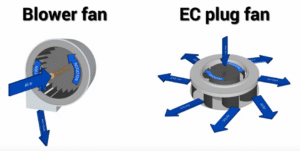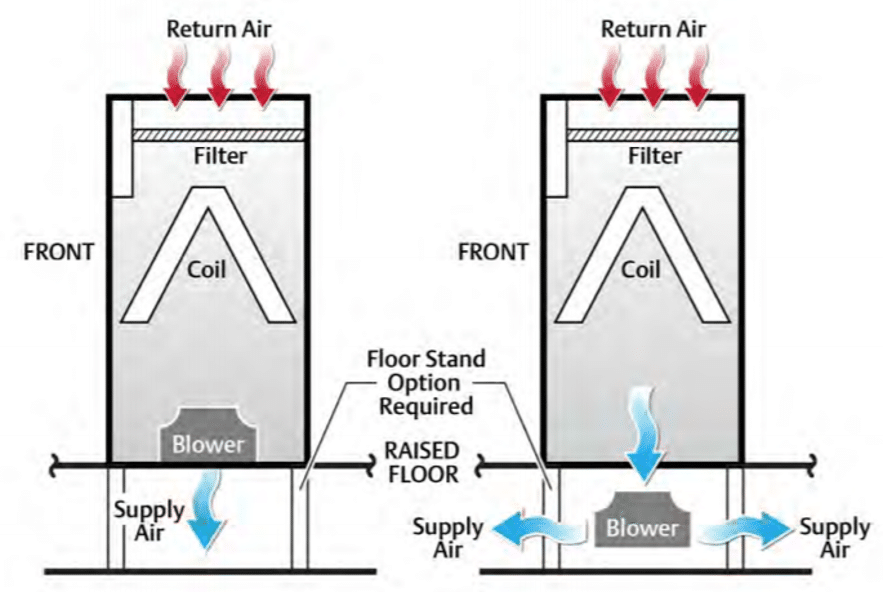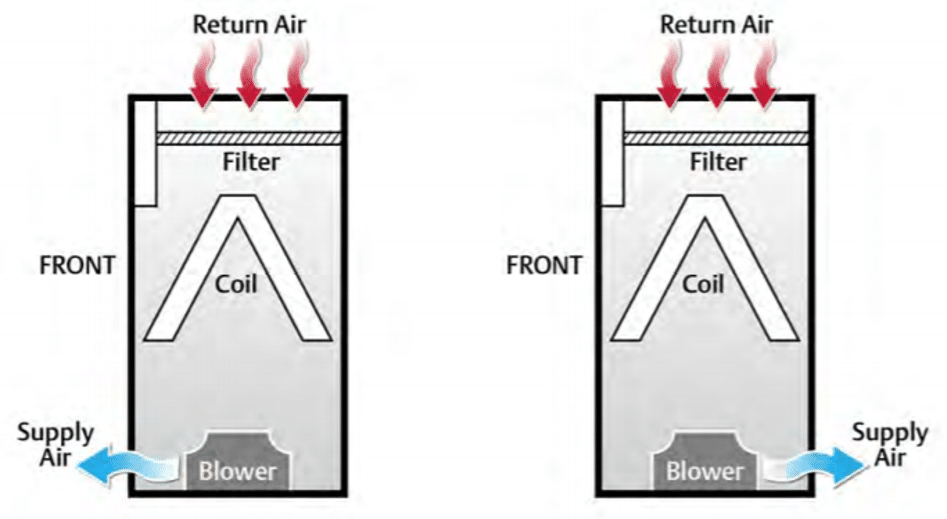EC plug fan retrofits are one of the most common and impactful ways that I find to reduce data center energy consumption. This article is meant for data center owners and operators of facilities served by CRACs or CRAHs[1] with constant speed fans. Here are some helpful tools for determining when you should consider a retrofit and why.
What Are EC Plug Fans?
The phrase “EC plug fan” includes two technologies: electronically commutated (EC) motors and plug fans. They’re also referred to as “EC fans” or “plug fans”. When if reference to CRACs and CRAHs, the two technologies will always be used together.
EC Motors
EC motors (sometimes referred to as ECMs or ECM motors), are efficient DC motors that can have variable speed control without the use of VFDs. They’re popular for small motors such as walk-in cooler evaporator fans, condensers and residential furnace fans because they tend to be far more efficient than their AC alternatives. Their main advantage at larger sizes isn’t their motor efficiency but the fan efficiency they enable in combination with plug fans.
Plug Fans
Plug fans are direct-drive fans that do not require belts or VFDs. They’re easy to install, quiet, low maintenance, and have a higher efficiency than typical forward-curved centrifugal fans. Plug fans are designed to pull air in vertically and push air out horizontally. The graphic below shows a comparison of the two technologies.
 Figure 1: Comparison of Centrifugal Blower Fan (left) and EC fan (right). Source: futurefacilities
Figure 1: Comparison of Centrifugal Blower Fan (left) and EC fan (right). Source: futurefacilities
Fan Configurations to Reduce Data Center Energy Consumption
In my experience, the most common retrofits are for CRAC/Hs serving raised floors. The most efficient approach is to mount the fan below the floor so that air can be directed outwards, as shown on the right, below. Unfortunately retrofits usually place the fans inside the unit, as shown on the left, due to space restrictions. To fit the fan below the floor, there must be 18” of vertical space without obstructions from floor stands.
 Figure 2: Downflow Configurations for EC fans Serving Raised Floors. Source: Vertiv.com
Figure 2: Downflow Configurations for EC fans Serving Raised Floors. Source: Vertiv.com
The following figures show additional configuration options. Upflow configurations are possible but require installing a fan plenum outside the unit. For those situations, installing a VFD to reduce fan speed is the most economical way to go.
 Figure 3: Additional Configurations for EC fans. Source: Vertiv.com
Figure 3: Additional Configurations for EC fans. Source: Vertiv.com
Impact on Data Center Energy Consumption
EC fan retrofits can reduce energy consumption by both reducing airflow and improving fan efficiency. Even without changing the airflow, you can expect to reduce energy consumption substantially. Reduce the fan speed as well and the savings jump quickly. The table below shows the expected energy savings at different fan speeds for a Liebert CRAH retrofit. Note how the savings for a VFD (VSD) retrofit are also good, but significantly less. The graph also shows the value of mounting the fans below the floor if possible.
 Table 1: Liebert CRAH Test Results for VFD and EC Fan Retrofits[2]. Baseline Fan Motor Power of 11 kW.
Table 1: Liebert CRAH Test Results for VFD and EC Fan Retrofits[2]. Baseline Fan Motor Power of 11 kW.
The dramatic savings resulting from reduced fan speed emphasizes the importance of good fan speed control. The next section outlines options for maximizing these savings.
Maximizing Energy Savings
To maximize the energy savings from an EC fan retrofit, we recommend performing a detailed energy analysis to consider complimentary efficiency measures. The following are some ideas that may be relevant to your facility:
- Optimize Fan Control
- Choosing the best control approach can be critical to realizing major savings.
- Integrate control with building automation system. EC fan retrofits often entail CRAC/H controller upgrades, which allow for this integration. This can often present the most efficient controls options.
- Some CRAC/H controllers can be networked without the use of your Building Automation System (BAS). This isn’t as flexible as integrating with a BAS but may be appropriate for your facility.
- Improve Airflow Management to Allow for Reduced Airflow
- Install aisle containment
- Optimize placement of supply tiles
- Install blanking panels
- Consider Economizing Potential
- Reducing the airflow will increase the return air temperature to the CRAC/Hs. This will improve the effectiveness of an economizer.
- Considering the savings from an existing economizer (free cooling coil, refrigerant economizer, air-side economizer) will improve the financial analysis.
- It may make sense to upgrade an existing economizer or even install new equipment for economizing.
Why It’s Probably Time for the Retrofit
If your CRAC/Hs can be retrofit with EC fans, it’s very likely that this is a great opportunity for you. Of course, it’s best to have an expert come review the specifics of your facility before implementing, but it’s never too early to start the conversation. Drop the excuses and start discussing the potential to reduce your data center energy consumption with this measure. Here’s why:
- You will save a lot of energy and your investment will pay off quickly
- The payback will likely be under 3 years, particularly when combined with complimentary efficiency measures.
- This is a common, relatively straight forward retrofit with predictable results.
- Major brands like Liebert and Stultz have retrofit kits.
- Well-proven technology
- EC fans are now the standard for new high-quality downflow CRAC and CRAH units. You can see here how Liebert only offers centrifugal fans for upflow units in their standard CRACs.
- The retrofit can open new opportunities for additional energy savings
- Replacing your fans and motors will likely extend the life of your CRAC/H
- Particularly for a CRAH unit, that doesn’t have many other moving parts, this can extend the unit life by many years.
- EC fans don’t require belts
- Improves efficiency
- Reduces maintenance cost
- Eliminates dust from the belt wear
- Improves fan redundancy
- Each fan has its own motor instead of multiple fans driven by one.
- Savings my help justify a controls upgrade
Next Steps
- Reach out to a sales representative for your brand of CRAC/H and verify that retrofit kits are available. You may need a serial number. They can also provide you with a quote for implementation.
- Consider an energy audit for your facility.
- Even if you’re confident you want an EC fan retrofit at this point, having an expert come in will provide you with critical implementation details. Considering controls options, complimentary efficiency measures, and the specifics of your application will most likely lead to higher savings and an overall better result.
- An audit can also provide useful financial analysis to help secure funding and justify a utility incentive. If you’d like to talk about energy audits, contact us anytime.
[1] To clarify, CRACs (Computer room air conditioners) have direct expansion (DX) cooling coils and CRAHs (Computer Room air handlers) have chilled water cooling coils. There are some details to pay attention to, but both can be retrofit with EC plug fans.
[2] https://www.vertiv.com/globalassets/shared/energy-efficiency-ebook-vsd-and-ec-fans_00.pdf
Title photo source: Vertiv.com

